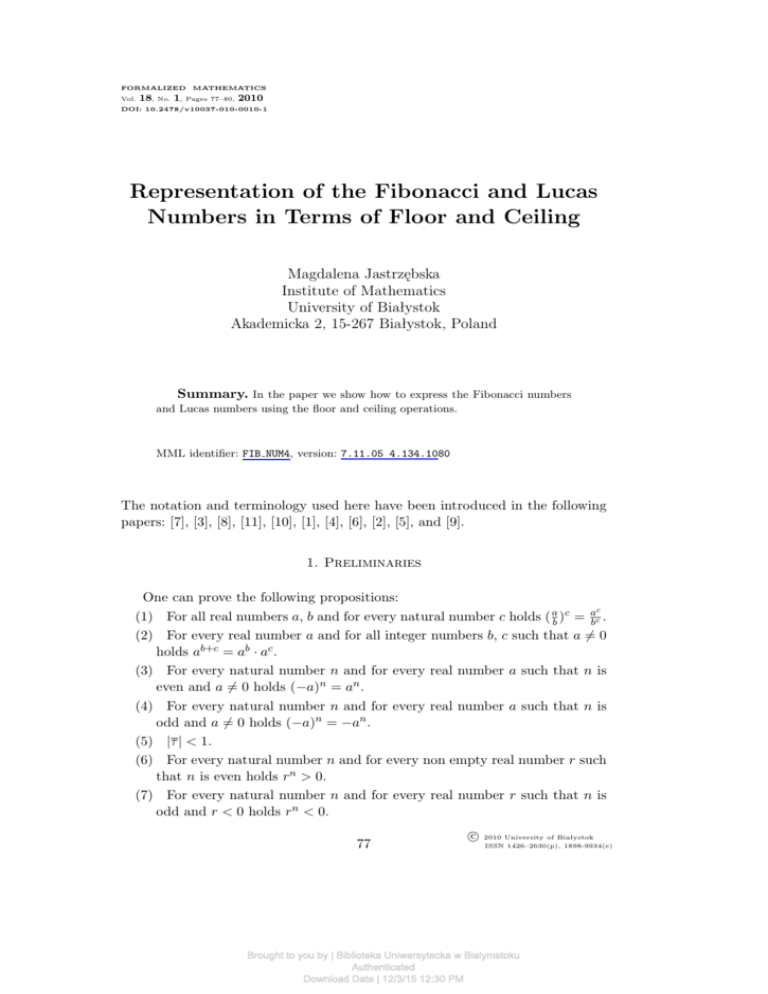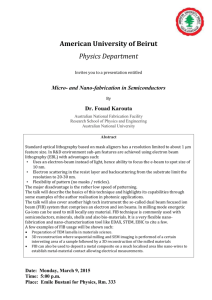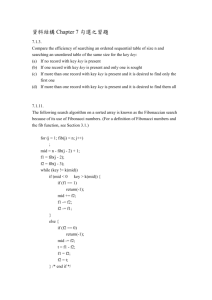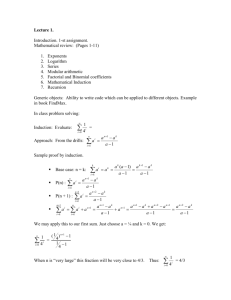Representation of the Fibonacci and Lucas Numbers in Terms of
advertisement

FORMALIZED Vol. MATHEMATICS 18, No. 1, Pages 77–80, 2010 DOI: 10.2478/v10037-010-0010-1 Representation of the Fibonacci and Lucas Numbers in Terms of Floor and Ceiling Magdalena Jastrzębska Institute of Mathematics University of Białystok Akademicka 2, 15-267 Białystok, Poland Summary. In the paper we show how to express the Fibonacci numbers and Lucas numbers using the floor and ceiling operations. MML identifier: FIB NUM4, version: 7.11.05 4.134.1080 The notation and terminology used here have been introduced in the following papers: [7], [3], [8], [11], [10], [1], [4], [6], [2], [5], and [9]. 1. Preliminaries One can prove the following propositions: c (1) For all real numbers a, b and for every natural number c holds ( ab )c = abc . (2) For every real number a and for all integer numbers b, c such that a 6= 0 holds ab+c = ab · ac . (3) For every natural number n and for every real number a such that n is even and a 6= 0 holds (−a)n = an . (4) For every natural number n and for every real number a such that n is odd and a 6= 0 holds (−a)n = −an . (5) |τ | < 1. (6) For every natural number n and for every non empty real number r such that n is even holds rn > 0. (7) For every natural number n and for every real number r such that n is odd and r < 0 holds rn < 0. 77 c 2010 University of Białystok ISSN 1426–2630(p), 1898-9934(e) Brought to you by | Biblioteka Uniwersytecka w Bialymstoku Authenticated Download Date | 12/3/15 12:30 PM 78 magdalena jastrzębska (8) For every natural number n such that n 6= 0 holds τ n < 21 . (9) For all natural numbers n, m and for every real number r such that m is odd and n ≥ m and r < 0 and r > −1 holds rn ≥ rm . (10) For all natural numbers n, m such that m is odd and n ≥ m holds τ n ≥ τ m. (11) For all natural numbers n, m such that n is even and m is even and n ≥ m holds τ n ≤ τ m . (12) For all non empty natural numbers m, n such that m ≥ n holds Luc(m) ≥ Luc(n). (13) For every non empty natural number n holds τ n > τ n . (14) For every natural number n such that n > 1 holds − 21 < τ n . (15) For every natural number n such that n > 2 holds τ n ≥ − √15 . (16) For every natural number n such that n ≥ 2 holds τ n ≤ (17) For every natural number n holds τn √ 5 + 1 2 > 0 and τn √ 5 + √1 . 5 1 2 < 1. 2. Formulas for the Fibonacci Numbers Next we state two propositions: τn + 12 c = Fib(n). (18) For every natural number n holds b √ 5 n τ (19) For every natural number n such that n 6= 0 holds d √ − 12 e = Fib(n). 5 We now state a number of propositions: 2·n (20) For every natural number n such that n = 6 0 holds b τ√5 c = Fib(2 · n). 2·n+1 (21) For every natural number n holds d τ √5 e = Fib(2 · n + 1). (22) For every natural number n such that n ≥ 2 and n is even holds Fib(n + 1) = bτ · Fib(n) + 1c. (23) For every natural number n such that n ≥ 2 and n is odd holds Fib(n + 1) = dτ · Fib(n) − 1e. (24) For every natural number n such that n ≥ 2 holds Fib(n + 1) = √ b Fib(n)+ 25·Fib(n)+1 c. (25) For every natural number n such that n ≥ 2 holds Fib(n + 1) = √ d (Fib(n)+ 5·Fib(n))−1 e. 2 √ Fib(n)+ 5·Fib(n)2 +4·(−1)n (26) For every natural number n holds Fib(n + 1) = . 2 (27) For every √ natural number n such that n ≥ 2 holds Fib(n + 1) = Fib(n)+1+ (5·Fib(n)2 −2·Fib(n))+1 c. b 2 (28) For every natural number n such that n ≥ 2 holds Fib(n) = b τ1 · (Fib(n + 1) + 12 )c. Brought to you by | Biblioteka Uniwersytecka w Bialymstoku Authenticated Download Date | 12/3/15 12:30 PM Representation of the Fibonacci and . . . 79 (29) For all natural numbers n, k such that n ≥ k > 1 or k = 1 and n > k holds bτ k · Fib(n) + 21 c = Fib(n + k). 3. Formulas for the Lucas Numbers Next we state a number of propositions: (30) For every natural number n such that n ≥ 2 holds Luc(n) = bτ n + 12 c. (31) For every natural number n such that n ≥ 2 holds Luc(n) = dτ n − 21 e. (32) For every natural number n such that n ≥ 2 holds Luc(2 · n) = dτ 2·n e. (33) For every natural number n such that n ≥ 2 holds Luc(2 · n + 1) = bτ 2·n+1 c. (34) For every natural number n such that n ≥ 2 and n is odd holds Luc(n + 1) = bτ · Luc(n) + 1c. (35) For every natural number n such that n ≥ 2 and n is even holds Luc(n + 1) = dτ · Luc(n) − 1e. (36) For every natural number n such that n 6= 1 holds Luc(n + 1) = √ Luc(n)+ 5·(Luc(n)2 −4·(−1)n ) . 2 (37) For every √ natural number n such that n ≥ 4 holds Luc(n + 1) = Luc(n)+1+ (5·Luc(n)2 −2·Luc(n))+1 b c. 2 (38) For every natural number n such that n > 2 holds Luc(n) = b τ1 ·(Luc(n+ 1) + 12 )c. (39) For all natural numbers n, k such that n ≥ 4 and k ≥ 1 and n > k and n is odd holds Luc(n + k) = bτ k · Luc(n) + 1c. References [1] Grzegorz Bancerek. The ordinal numbers. Formalized Mathematics, 1(1):91–96, 1990. [2] Grzegorz Bancerek and Piotr Rudnicki. Two programs for SCM. Part I – preliminaries. Formalized Mathematics, 4(1):69–72, 1993. [3] Czesław Byliński. The complex numbers. Formalized Mathematics, 1(3):507–513, 1990. [4] Yoshinori Fujisawa, Yasushi Fuwa, and Hidetaka Shimizu. Public-key cryptography and Pepin’s test for the primality of Fermat numbers. Formalized Mathematics, 7(2):317–321, 1998. [5] Krzysztof Hryniewiecki. Basic properties of real numbers. Formalized Mathematics, 1(1):35–40, 1990. [6] Konrad Raczkowski and Andrzej Nędzusiak. Real exponents and logarithms. Formalized Mathematics, 2(2):213–216, 1991. [7] Piotr Rudnicki and Andrzej Trybulec. Abian’s fixed point theorem. Formalized Mathematics, 6(3):335–338, 1997. [8] Robert M. Solovay. Fibonacci numbers. Formalized Mathematics, 10(2):81–83, 2002. [9] Andrzej Trybulec and Czesław Byliński. Some properties of real numbers. Formalized Mathematics, 1(3):445–449, 1990. [10] Michał J. Trybulec. Integers. Formalized Mathematics, 1(3):501–505, 1990. Brought to you by | Biblioteka Uniwersytecka w Bialymstoku Authenticated Download Date | 12/3/15 12:30 PM 80 magdalena jastrzębska [11] Piotr Wojtecki and Adam Grabowski. Lucas numbers and generalized Fibonacci numbers. Formalized Mathematics, 12(3):329–333, 2004. Received November 30, 2009 Brought to you by | Biblioteka Uniwersytecka w Bialymstoku Authenticated Download Date | 12/3/15 12:30 PM








